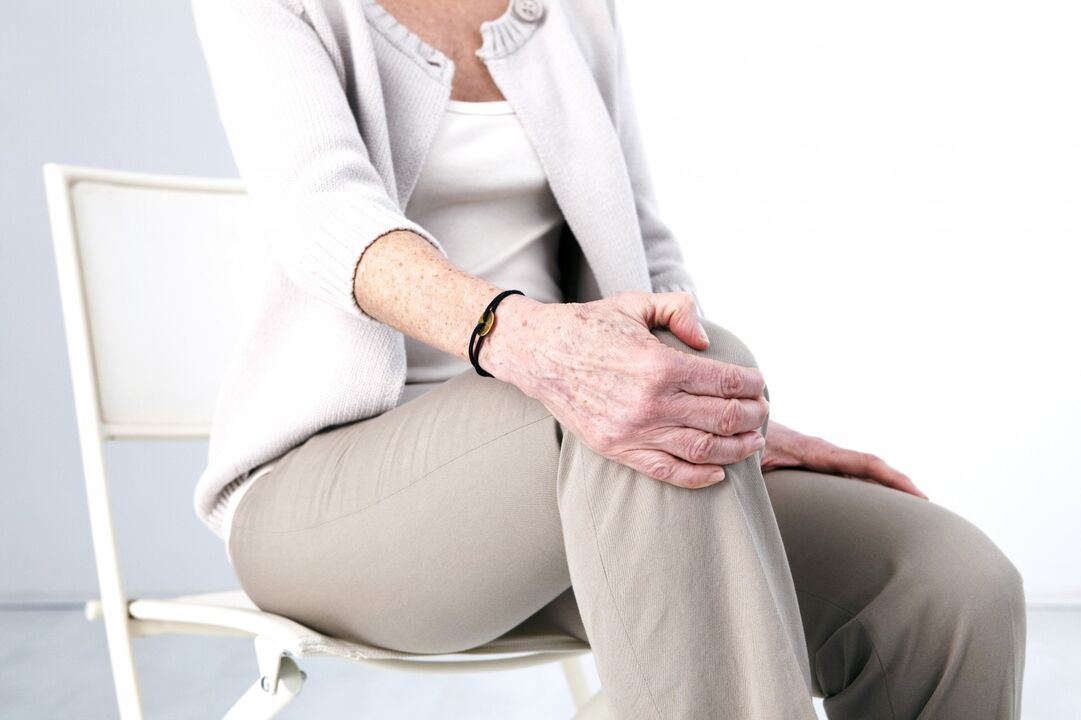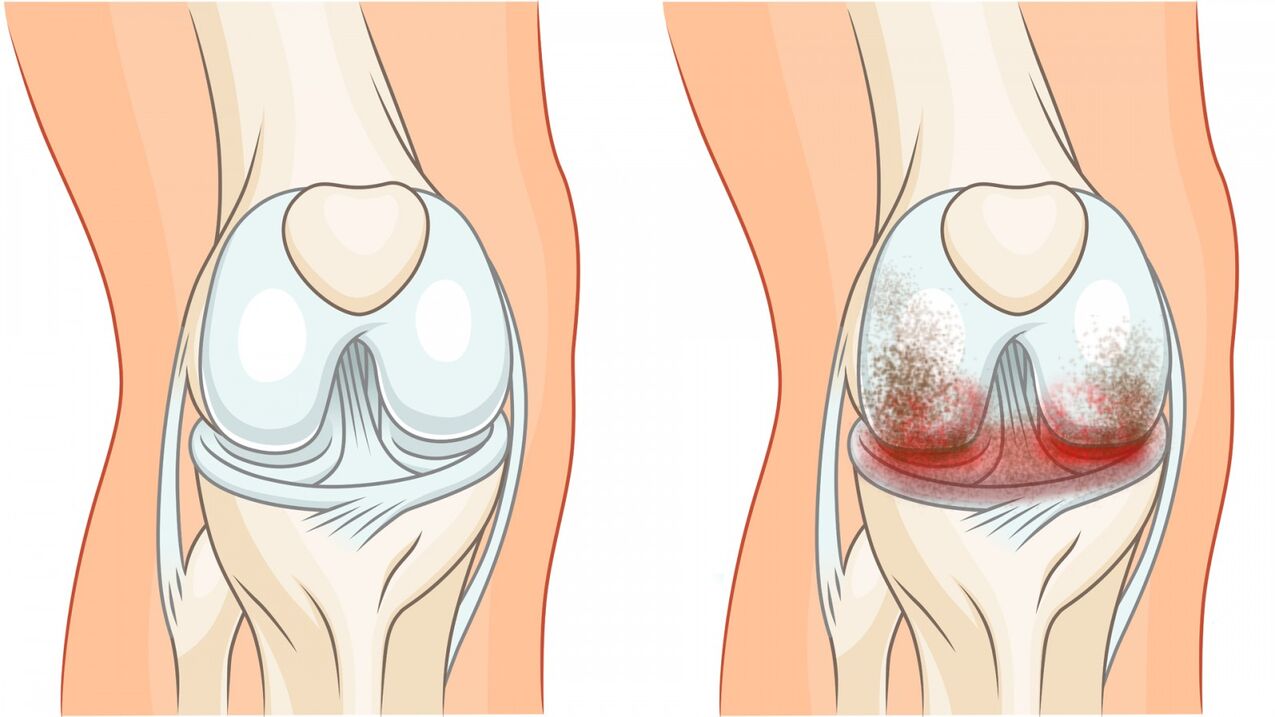Knee pain is a common complaint that they see a doctor with. What is causing the pain and how can you help yourself if it occurs? There is no one-to-one answer because knee joints can suffer from different types of lesions that appear for many reasons. One of these reasons (and very often) is the onset of osteoarthritis. Today we will tell you in detail about osteoarthritis of the knee joint: what are its causes, types, symptoms and signs, we will talk about methods of treatment and prevention.
Types and causes of the disease
Osteoarthritis of the knee or gonarthrosis is a predominantly non-inflammatory lesion that ultimately leads to the destruction of the articular cartilage, a deformity of the knee and a limitation of the range of motion. The disease has two main forms:
- primary - arises from a congenital joint defect;
- secondary - arises as a result of other diseases or injuries.
The primary form begins to develop in childhood or adolescence and is caused by improper development of the joint surfaces or the ligamentous apparatus. When walking, such a joint is subjected to stress that is disproportionate to its capabilities, which causes degenerative changes in it.
The development of secondary pathology can lead to:
- Injuries: broken bones of the legs, bruises and dislocations of the knee, accompanied by damage to the bone and cartilage parts of the joint and its ligaments. In this case, post-traumatic osteoarthritis of the knee joint develops.
- Operations to remove the meniscus, as they lead to a violation of the integral structure of the knee and its rapid wear and tear.
- The disproportionately high load on the legs that athletes often expose themselves to.
- Excessive obesity also leads to osteoarthritis as it creates excessive pressure of body weight on the articular cartilage of the knee.
- Arthritis is inflammation of the joints. Long-term arthritis involves the build-up of fluid in the joint cavity, and osteoarthritis can complicate it over time.
- Metabolic disorders that lead to the deposition of salts in the joint cavities.
- Other factors and diseases that are accompanied by long-term spasm of the leg muscles or blood vessels.
- Transferred Operations.
The pathological process can be unilateral or bilateral. As a result of trauma, unilateral osteoarthritis (for example, of the right knee), and obesity - bilateral, is most likely to develop.

Typical symptoms
Osteoarthritis of the knee joint develops gradually, sometimes months and years precede it from the beginning, when there are still no obvious symptoms (such as severe pain and visible deformities), but from time to time there is a feeling of malaise in the knees.
Overweight women over 40 years of age are most likely to get sick and suffer from varicose veins as an aggravating factor.
The development of osteoarthritis of the knee goes through several stages:
- The initial stage can take months and sometimes years. A person is concerned about periodic knee pain, especially during the first few steps after getting up in the morning and when climbing and descending stairs.
- In the second stage, the pain becomes stronger and occurs even with movements that are accompanied by a characteristic crunch. A build-up of fluid is possible in the joint cavity, and upon examination, you can determine an incipient deformation. The range of motion in the painful knee decreases.
- The third stage is characterized by pain that does not go away even at rest. The symptoms are often worse before the weather changes. At this point, the joints have largely lost their functions: the legs can hardly bend at the knees, or not bend to the end. The gait changes: it becomes "waddling" or on bent legs. The deformation of the knees is very pronounced: the legs are bent and assume an O or X shape.
The symptoms of post-traumatic osteoarthritis of the knee joint develop more quickly. Against the background of the injury, pain in the knee area and its swelling appear. Such pains constantly accompany a person and increase after physical exertion. Gradually there is a feeling of tightness and stiffness in the knee. Sometimes with this form of the disease it only takes a few months from the first signs to irreversible changes.

Treatment of osteoarthritis of the knee
The extent of treatment depends on the stage of the disease and the severity of the lesion. However, since the disease is chronic, only long-term remission (periods of rest with minimal or no manifestations of pathology) can be achieved. If at the same time it is possible to get rid of the cause of osteoarthritis of the knee joint (for example, to reduce body weight), then an almost complete recovery is possible.
Goals of osteoarthritis treatment:
- Eliminate pain,
- if possible restore the damaged cartilage and ligament apparatus,
- increase the range of motion in the joint.
Treatment methods:
- Drug therapy,
- Massage and manual therapy,
- surgical intervention,
- Rehabilitation therapy (exercise therapy, physiotherapy and other methods).
Only a doctor can choose the right medication - in no case do not prescribe it yourself. Your main action is aimed at:
- Eliminating the symptoms of osteoarthritis of the knee joint: relieving pain and inflammation. To do this, appropriate drugs are prescribed, including hormones that are injected into the joint cavity.
- Improving the blood supply to the affected area. It is provided by means that relieve vascular spasms and relax muscles.
- Restoration of cartilage. To do this, drugs are prescribed that nourish and restore cartilage.
Manual strokes and massage relieve pain, relax the spasmodic muscles near the affected knee, help increase the range of motion, correct the position of the bones, and increase blood flow.
With extensive, irreversible lesions, knee osteoarthritis is treated with a radical method - prosthetics, that is, implantation of a metal prosthesis to replace the destroyed joint. So far, this is the only way that allows a full recovery, but endoprostheses have a limited lifespan, after which they must be replaced. Since the costs of such operations are very high, this method of treatment has not yet caught on.
Rehabilitation therapy includes physical therapy, exercise therapy (exercises with special loads and simulators), physiotherapy and spa treatments.
Orthopedic methods are aimed at relieving the painful knee - these are sticks, orthotics, etc. that make walking easier (if necessary).
There are many folk recipes for various ointments and compresses based on herbs, medicinal bile and warming bandages made of natural wool. Basically, the action of such methods is aimed at relieving pain and eliminating the main symptoms.
Preventive measures
Prevention of knee osteoarthritis includes many factors:
- Balanced diet: The diet should contain an adequate amount of proteins, vitamins and minerals.
- Fight the wrong way of life and get rid of bad habits.
- Weight normalization.
- Sufficient physical activity.
- Injury prevention in sports, weightlifting.
The most important thing in identifying such a pathology as knee osteoarthritis is not to trigger the disease, since its far-reaching stages lead to disability. But if all efforts are directed towards treatment and prevention in a timely manner - until the time is lost and symptoms are insignificant - there is a chance of a complete cure for the disease.




























